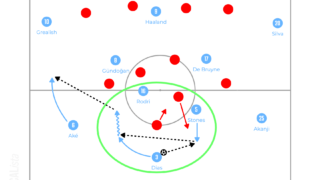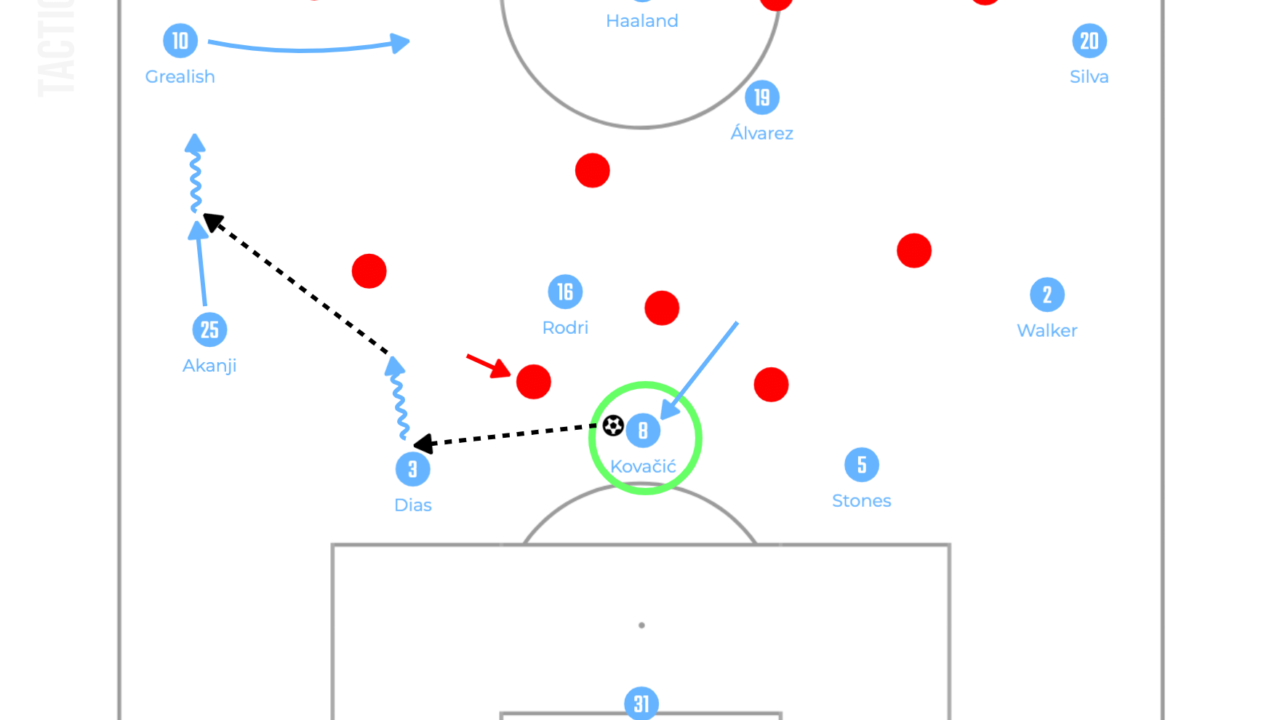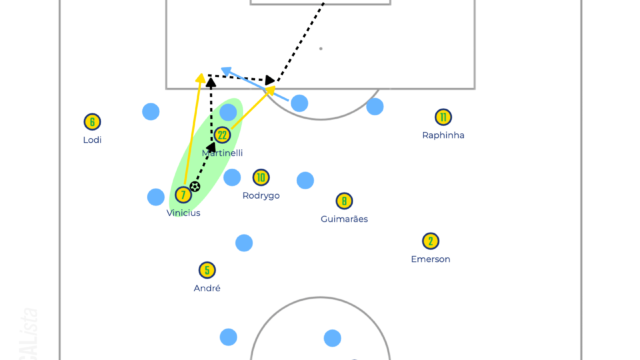Introduction
Manchester City, the treble winners began their season with the first ever UEFA Super Cup title by beating Sevilla on penalties after losing Arsenal on penalties in the FA Community Shield and three straight wins in the league. It is always tough to motivate and improve the team after achieving their biggest dream, but City stay focusing on this new season with several changes in the squad.
The captain İlkay Gündoğan departed for FC Barcelona and João Cancelo is likely to join him (when I am writing this article, it is said he will join Barcelona on loan). Moreover, the centre back Aymeric Laporte signed for Al-Nassr. To replace them, although giving up singing Declan Rice who eventually joined Arsenal, City secured two experienced and young talented Croatians, Mateo Kovačić from Chelsea and Joško Gvardiol from RB Leipzig. Additionally, following the departure of Riyad Mahrez for Al-Ahali, young Belgian winger Jérémy Doku joined City from Stade Rennais.
Additionally, to strengthen the midfield to cover the injury of Kevin De Bruyne, Matheus Nunes has singed for City from Wolverhampton Wanderers. There are some moves of young players including Cole Palmer who just joined Chelsea, but main squad was formed by those changes.
In this article, City’s first five competitive games are going to be analysed to identify their current strengths and weaknesses and what is expected for the new players. I hope you enjoy this article.

Build up
Last season, Pep Guardiola found a way to play with four central defenders to secure defensive stability thanks to the breakthrough of John Stones as a defensive midfielder. This season, another clever defender Manuel Akanji plays his role in the midfield due to the injury of Stones and adds his strength. In addition to this, Kovačić’s ability to keep the possession in front of the opposition midfield and carry the ball forward is making difference. Let’s explore the tactics of building up in detail.
In building up, there are both similarities and differences from last season. Firstly, some similarities are going to be analysed. What made City’s build up stable last season was the flexibility at the back.

As it was deeply discussed in the article above, both defensive midfielders Rodrigo and Stones often dropped into the back line and pushed the wide centre backs higher to break the opposition first line. This flexibility makes it difficult for the opposition attackers to constantly apply pressure on the player with the ball, so City could maintain the possession comfortably.
This season, due to the injury of Stones and thanks to the addition of Kovačić, the role of moving between the midfield and the back line is played by Rodrigo and Kovačić (or sometimes Bernardo Silva). Unlike Stones, Akanji or Rico Lewis can step up into the midfield, but they hardly drop into the back line. However, thanks to Kovačić, City can keep two players who can make the shape at the back flexible.

Then, the defensive midfielder between the centre backs can attract the opposition attackers in the middle to create space for one of the centre backs and he steps in and plays to the fullback to break the opposition midfield line by playing around. This idea is similar to what City did last season and still works brilliantly as a secured way to progress the ball.
The biggest difference is the absence of the right winger. So far, only Palmer kept the width in the right flank against Sevilla in the Super Cup and Silva or Foden often came inside when they played as the right winger this season. Usually, keeping the width is one of the main ideas of Pep’s football, but after the departure of Mahrez, the position of the right winger is vacant.
Instead of the winger, the fullback can fill the winger’s area, but when playing out from the back, the right fullback Kyle Walker usually stays deeper rather than going higher. Then, what is the reason of this?
The possible reason is playing through or over against aggressive man marking pressing. Nowadays many teams press high with man marking. By beating this pressing, De Zerbi’s Brighton succeeded last season. Pep also found his way to solve the problems against aggressive pressing.
The biggest advantage is that City can open the wide area and it is possible to consider it as the goal of building up.

Thanks to the inside position of the right winger, the opposition fullback is forced to leave the wide area and it is difficult for him to step up to apply pressure on City’s right fullback. If he jumps to the right fullback, City’s inside winger can be free in between the lines. Therefore, against aggressive pressing, one of the City’s aims is to find Walker or Jack Grealish, who drops back to be away from the opposition fullback, in wide areas.
When the opposition team presses high with man marking, playing over towards the attackers is an effective option thanks to the individual qualities.

Needless to say, the most important quality is the passing range of Ederson. In addition to this, the qualities of attackers make a difference. Julián Álvarez’s mobility can make it possible to break the opposition back line directly and Phil Foden can receive the lofted ball under pressure comfortably. Moreover, Erling Haaland can flick the ball by winning the aerial duel, so both Álvarez and Foden often start to run in behind as soon as Ederson strikes the ball. These are the options which City often execute against man marking pressing.
Final Third Attacking
Lacking De Bruyne due to the injury is a massive problem for City especially in attacking in the final third. He can score goals or provide assists from nothing, so City is expected to suffer when facing a low block team such as the game against Sheffield United which City narrowly won 2-1 with Rodrigo’s goal in the last minute. However, Pep’s team has organised attacking tactics which constantly provide goal scoring opportunities, although it depends on the individual qualities if a goal is scored or not. Let’s explore their tactics of attacking in the final third.
Many teams in the Premier League can close the gap in the middle and force the opposition team to play outside, even City cannot always play through the middle easily. Therefore, the final third attacking is often led by the wingers. However, as it was mentioned earlier, there is no winger in the right side, so the left winger Grealish has a huge responsibility to begin attacks. He has an exceptional ability to keep the ball and it can attract many opposition players around the ball. Therefore, even though he could not beat the opposition fullback, it is possible to create space for teammates.

Thanks to Grealish attracting some defenders around the ball, Rodrigo, Akanji or Kovačić can receive the ball with time and space in front of the box where they can take a shot or deliver a cross towards the back post area. City’s crosses are often delivered towards the back post area and the opposite side players are ready to receive the ball as they know where the ball will be delivered. Palmer actually scored the important equaliser against Sevilla from this pattern. This strategy of back post crosses can be applied when Grealish successfully beats the opposition fullback and Haaland is there to head the chipped ball in.
On the other hand, Walker, who is positioned higher in the right side, cannot take on the opposition fullback like Grealish. However, his speed can make a difference. He prefers to make a run in behind to receive through balls and deliver a cut back, which led the second goal against Burnley. Additionally, as it was described, he can be a target player at the back post from Rodrigo’s crosses. However, it is not the perfect position for him to keep the width higher up the pitch. Therefore, the new Belgian right winger Doku is expected to take on the opposition fullback like Grealish and wisely use Walker overlapping from the back.
Even though the space between the lines is always tight, Foden has a great ability to receive the ball there. His ability to turn forwards quickly and carry the ball towards the opposition centre backs is extremely effective in the final third. As soon as he receives the ball, Haaland or Álvarez make a run in behind to exploit a 2v1 against one of the opposition centre backs.

Lacking De Bruyne is tough for City, but they have many talented attackers, so it is difficult to think they will suffer with a lack of goals. However, if it comes to games against teams who focus on parking the bus, the lack of threats from the right side can be a problem. To overcome this problem, Doku needs to add something in the right flank.
Pressing
When City dominate a game, it is often thanks to their good pressing. Pep always identifies the opposition build up style and adapts the pressing shape. However, there are some similarities in every game. Let’s begin with analysing their principles of pressing.
City press intensely as a team. This means they hardly start to press with man to man. First of all, they set an organised shape, which is usually a 4-4-2 but sometimes a 4-3-3 depending on the opposition shape. Then, as soon as the opposition goalkeeper plays to one of the opposition centre backs, one of the attackers starts to press on the ball. City try to lock the opposition in and players around the ball mark the opposition players tightly. Finally, if the opposition player on the ball forces to play long, the back line is strong in aerial duels and as soon as the second ball drops into the midfield, Rodrigo is always there to regain it. This is the flow of City’s pressing.
One of the characteristics of City’s pressing is the aggressiveness on the opposition players within the compact shape. Against the opposition defensive midfielders, Rodrigo and Kovačić often step up to mark them tightly. Additionally, the centre backs also follow the opposition striker dropping back or press aggressively on spare players behind Rodrigo and Kovačić.

This intensity makes it difficult for the opposition team to find a spare player around the ball and City players can apply pressure on the ball tightly.
Another strength is the aggressive and collective line control when the opposition plays backwards. As soon as the ball is played backwards, all City players step up to lock them in the opposition half. When doing this, one of the key movements is the winger pressing to the centre back on the ball from the outside.

As the passing lane to the opposition fullback is cut by the winger, the opposition centre back can only play backwards, which enables City players to push the lines up. To do this, the wingers need to stay high and this is the key point for City to be successful in pressing.
Final Third Defending
The reason of the treble last season can be attributed to the solidity in the box. Not only just playing with four centre defenders but also their organisation is solid. Most players always come back to the box to protect the goal and this is the most important thing rather than tactics. City can do this and this is why they won the treble last season. And this continues in this season so far.
Firstly, City’s 4-4-2 shape is compact enough to force the opposition to play outside. As soon as the opposition wide player receives the ball, the fullback jumps to apply pressure and the winger come back to create a 2v1. Additionally, to protect the gap between the centre back and fullback, the defensive midfielder drops into the space to cover the channel. This triangle is often seen when City defend the box.

This triangle makes it possible for the near centre back to stay in front of the goal. This strengthens the protection against crosses and the other two midfielders also come back to cover the space in front of the back line. The organisation is strictly maintained by the players and that is the most important thing.
Then, as soon as the opposition player on the ball plays backwards, City push the lines up quickly and force them to play backwards further.
Conclusion
Man City is still evolving after winning the treble. The defending is as solid as last season and they still have clear ideas of scoring goals, even though they were supposed to suffer the absence of De Bruyne. Kovačić and Gvardiol are already playing well as main players and Nunes and Doku would add another option for Pep. They are still the greatest team in Europe. Thank you for reading. I hope you enjoyed this article.



